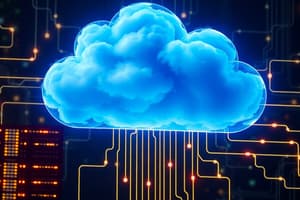Podcast
Questions and Answers
What are the desired features of a cloud computing system?
What are the desired features of a cloud computing system?
Scalability, flexibility, self-service provisioning, pay-per-use model.
Differentiate between Infrastructure as a Service (IaaS) and Platform as a Service (PaaS).
Differentiate between Infrastructure as a Service (IaaS) and Platform as a Service (PaaS).
IaaS provides virtualized computing resources over the internet, while PaaS provides a platform allowing customers to develop, run, and manage applications without dealing with infrastructure.
What is the role of Open Standards in cloud computing?
What is the role of Open Standards in cloud computing?
Open Standards ensure interoperability, compatibility, and portability across different cloud platforms and services.
Explain the concept of Identity as a Service in cloud computing.
Explain the concept of Identity as a Service in cloud computing.
How do virtualization technologies contribute to cloud computing?
How do virtualization technologies contribute to cloud computing?
What is the significance of load balancing in virtualized environments?
What is the significance of load balancing in virtualized environments?
Explain the trade cycle in E-Commerce.
Explain the trade cycle in E-Commerce.
What are the benefits and impacts of E-Commerce?
What are the benefits and impacts of E-Commerce?
Differentiate between E-Commerce and M-Commerce.
Differentiate between E-Commerce and M-Commerce.
Explain the basics of M-Commerce.
Explain the basics of M-Commerce.
What are the key components of Electronic Payment Systems?
What are the key components of Electronic Payment Systems?
Flashcards are hidden until you start studying




